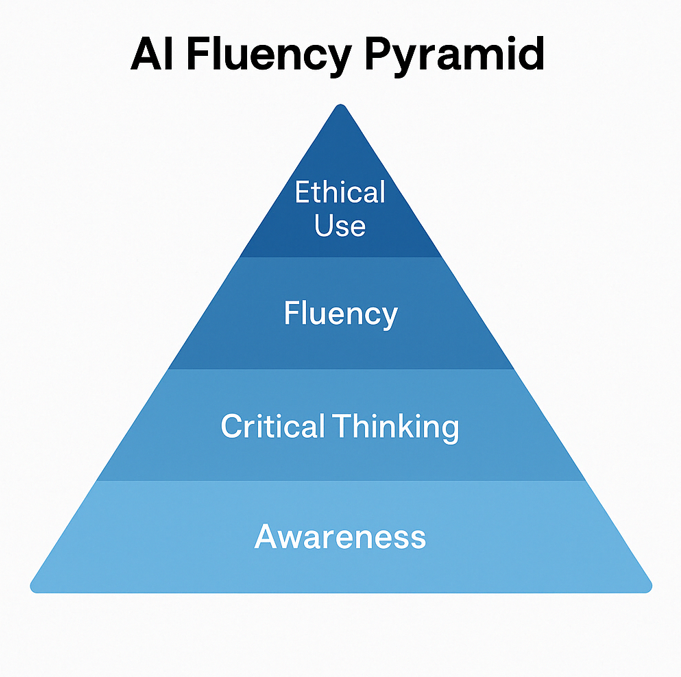
AI proficiency is a core skill that can reshape human interaction with technology, enabling employees to seamlessly navigate the challenges of the modern workplace with smarter, data-backed decision-making.
As AI takes the world by storm, AI proficiency is becoming as fundamental as digital literacy was, say a decade ago. In modern, tech-driven workplaces where AI is getting embedded in everyday tools and services, AI literacy is a critical skill that can empower professionals to enhance productivity and stay competitive in a dynamic workplace. However, despite AI training being essential for workers, data suggests that there is a notable gap between training and preparedness. Although 82% of leaders advocate skilling in AI, it is reported that only 38% of organizations are offering AI fluency training programs.
Having said that, understanding how AI works is not a big challenge; the real challenge lies in knowing how to apply it meaningfully in specific job roles and industries. This value addition through meaningful application requires context-driven use, which, in turn, requires critical thinking, creativity, and domain knowledge.
From Awareness to Fluency: Building AI Confidence
As more and more organizations integrate AI into daily tasks, AI proficiency is critical to empowering their workforces to transform how they work and add value. For instance, AI can automate routine tasks, allowing employees to gain actionable insights that can be used to enhance creativity in real-time. AI training can even empower non-experts to apply AI in their day-to-day works through AI training programs and no-code AI platforms.
With AI tools becoming increasingly accessible, employees must look beyond passive familiarization to actively integrate AI into daily workflows for greater productivity and competitive edge. By integrating AI into daily tasks like data analysis, content generation, or customer service, they can deliver high-quality outcomes and become more efficient, agile, and smart decision-makers.
Beyond Prompt Engineering: Developing AI Critical Thinking Skills
That AI is prone to biases is well-known. It is, therefore, crucial that employees are able to understand the biases that can alter algorithms and data, and deliver undesirable outcomes. These skewed outputs often result in flawed judgments. This is where human oversight can help interpret and assess AI-generated results for relevance, accuracy, and fairness.
AI fluency provides employees with the understanding of how AI systems process data and arrive at conclusions. However, to make informed decisions rather than accepting the outcomes of AI systems at face value, employees must be able to question, evaluate, and interpret the outputs that AI systems produce. This ability to question requires AI critical thinking, which also helps build accountability and transparency into AI systems and promote responsible use of AI across business functions and industries.
Across core business functions, AI is transforming how professionals work, make decisions, and deliver value:
- Marketing: AI helps marketers generate personalized emails, ads, and social media content at scale. It provides insights into customer behavior to refine strategy and boost ROI.
- HR: AI streamlines recruitment by automating resume screening and conducting initial interviews. Talent analytics help HR teams plan better and build people-first workplaces.
- L&D: AI personalizes learning by adapting content and pace to individual needs. It also identifies skill gaps and recommends targeted training paths.
In specific industries, AI is driving innovation, efficiency, and better service delivery:
- Healthcare: AI accelerates diagnoses, predicts risks, and personalizes care using real-time data from medical records and imaging. Virtual assistants also reduce admin loads.
- Manufacturing: AI powers predictive maintenance and quality control, helping reduce waste and downtime. It also optimizes supply chains for better efficiency.
- Travel & Hospitality: AI enables dynamic pricing, personalized recommendations, and faster customer support to elevate the guest experience.
- Software: AI improves development cycles, automates testing, and enhances user experience with features like chatbots, recommendation engines, and personalization.
To promote ethical and responsible use of AI, organizations must encourage their employees to question data sources, ensure transparency, and prioritize fairness in outcomes. Staying informed about evolving AI regulations and ethical frameworks, combined with adoption of practices that align with ethical standards, can help organizations leverage AI for fair, trustworthy, and positive use.
Conclusion
Whether you’re in HR, L&D, or operations—start by assessing where AI can save time and where employees need support to apply it effectively.
Upskilling for AI is in no way about replacing human work—it’s about adding value to their expertise. By automating routine and repetitive tasks, quickly analyzing large volumes of data, and offering insights, AI reduces the burden of mundane and enables humans to focus on innovation and strategy.
A human-centered approach for responsible use of AI can help organizations build a smarter version of themselves. This is achievable only through AI proficiency training programs that sensitize employees about potential harms AI can cause, and why critical thinking is essential when leveraging the power of AI at the workplace. With AI training, organizations can empower employees to add value to their work and amplify the ability to thrive in an AI-driven future.




